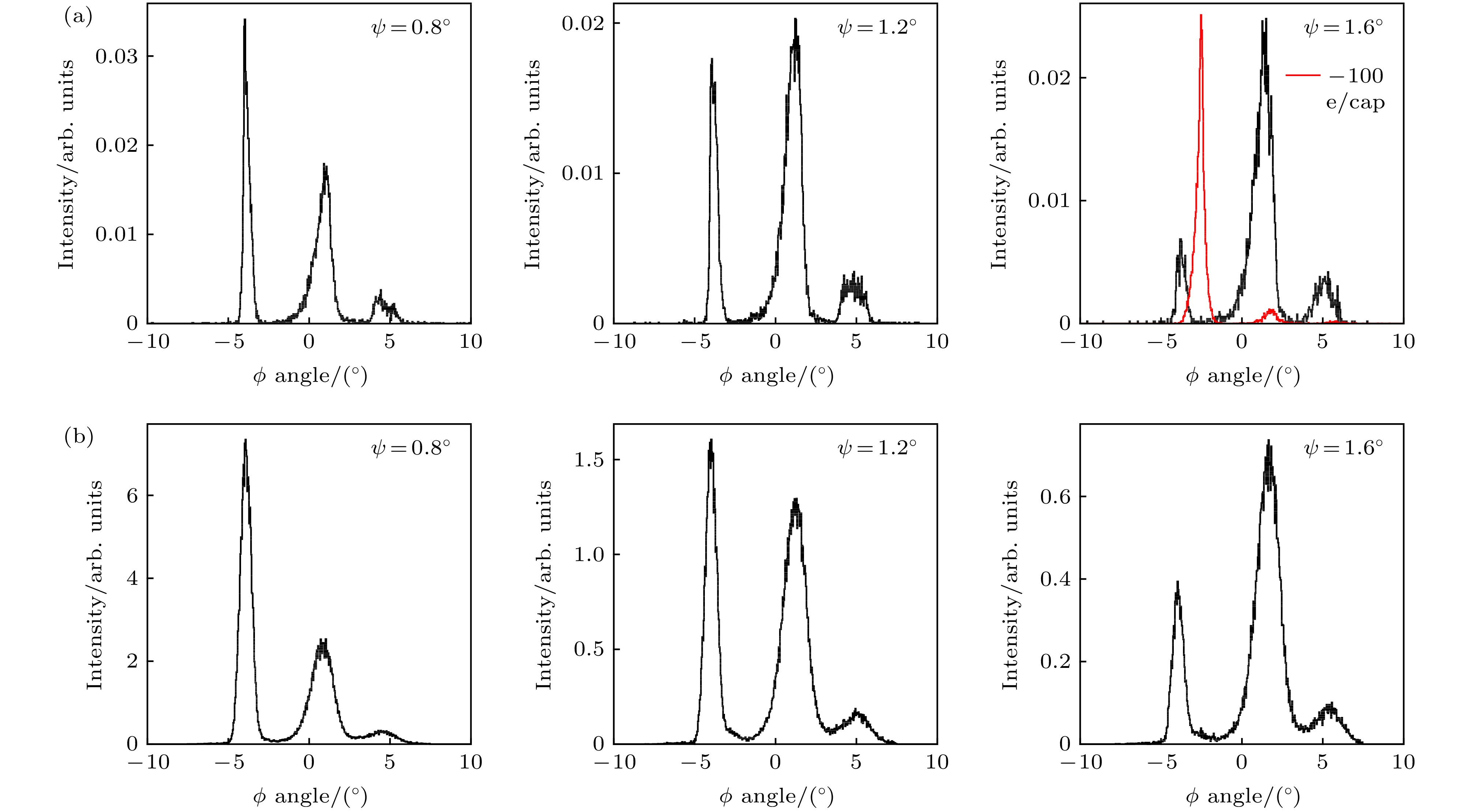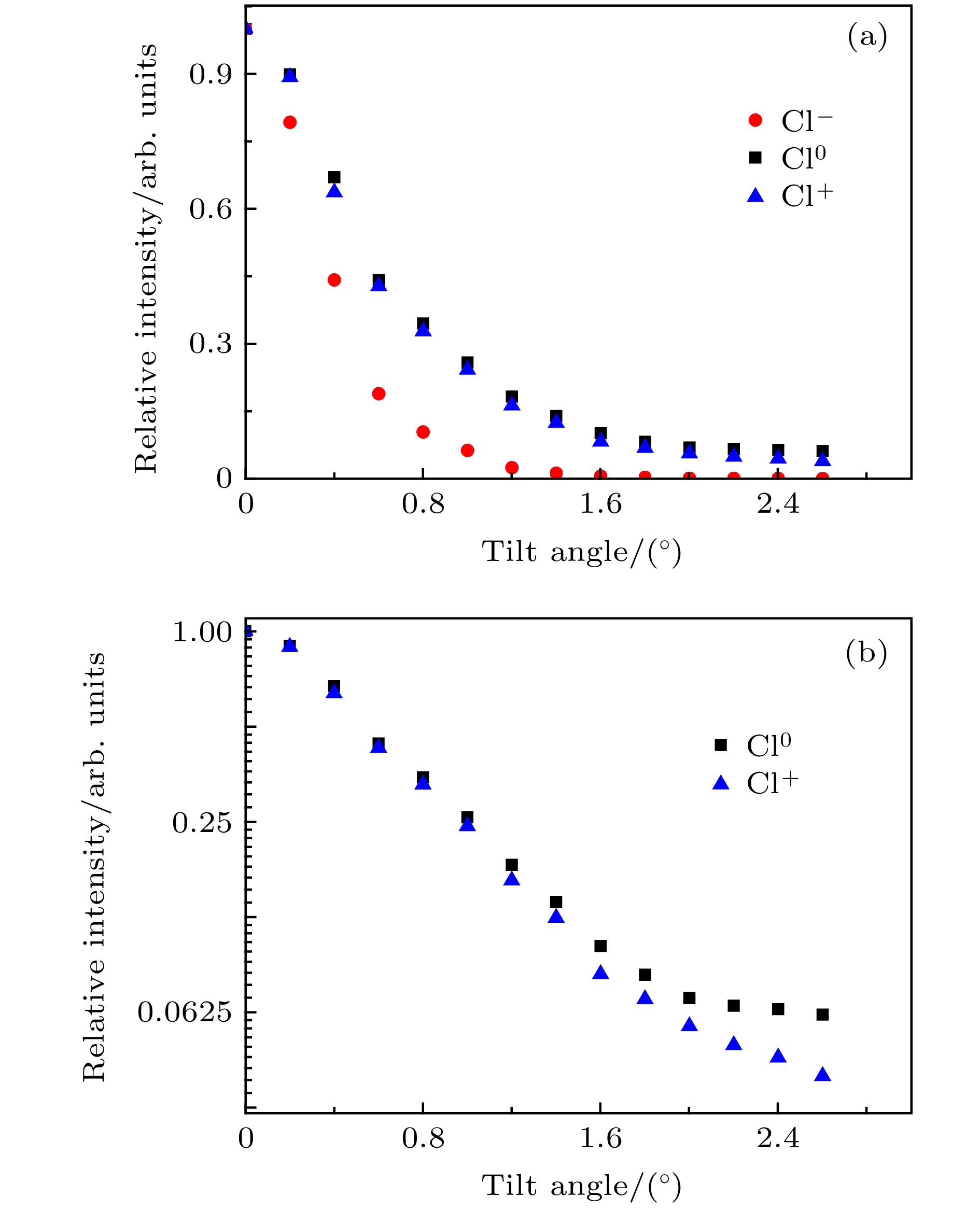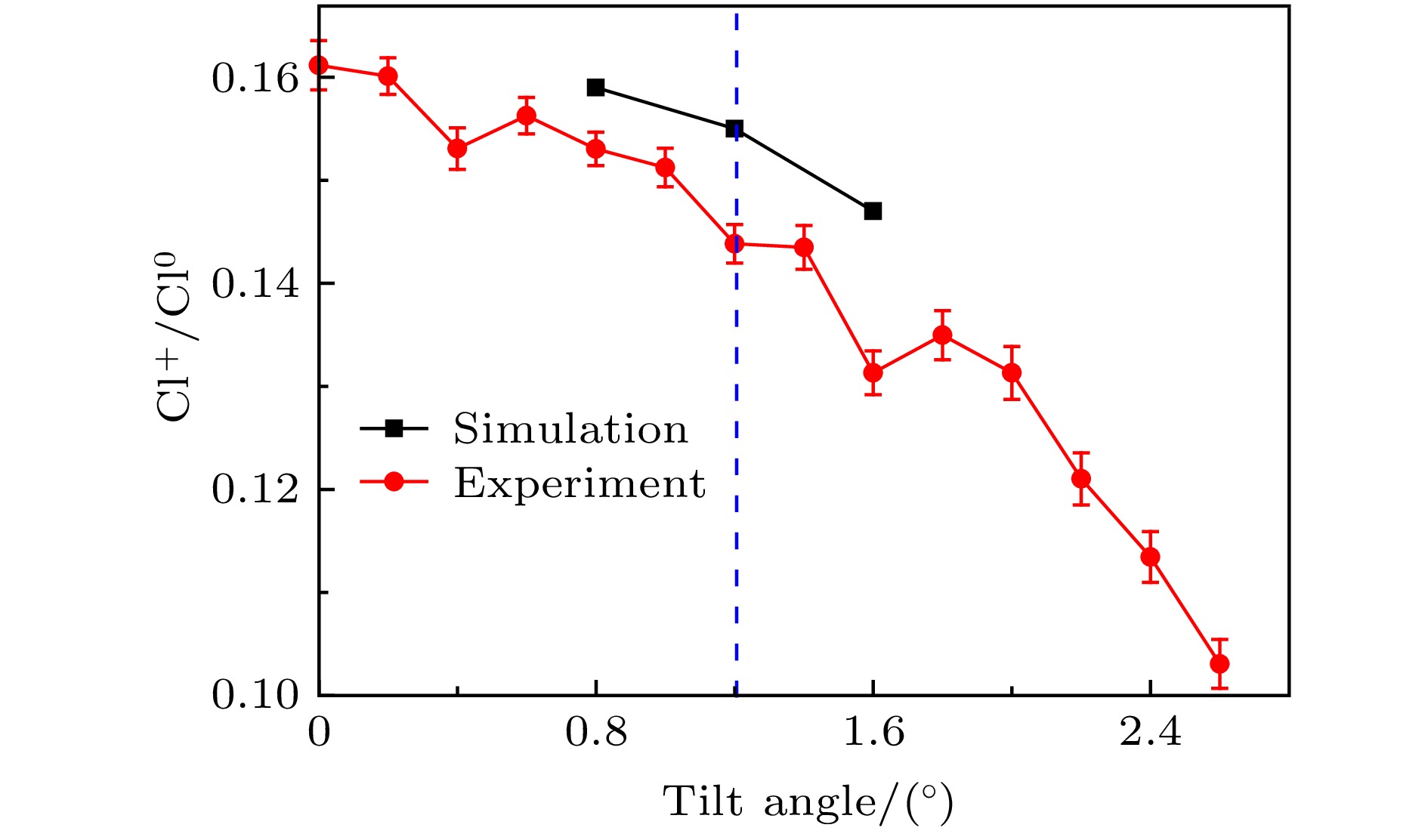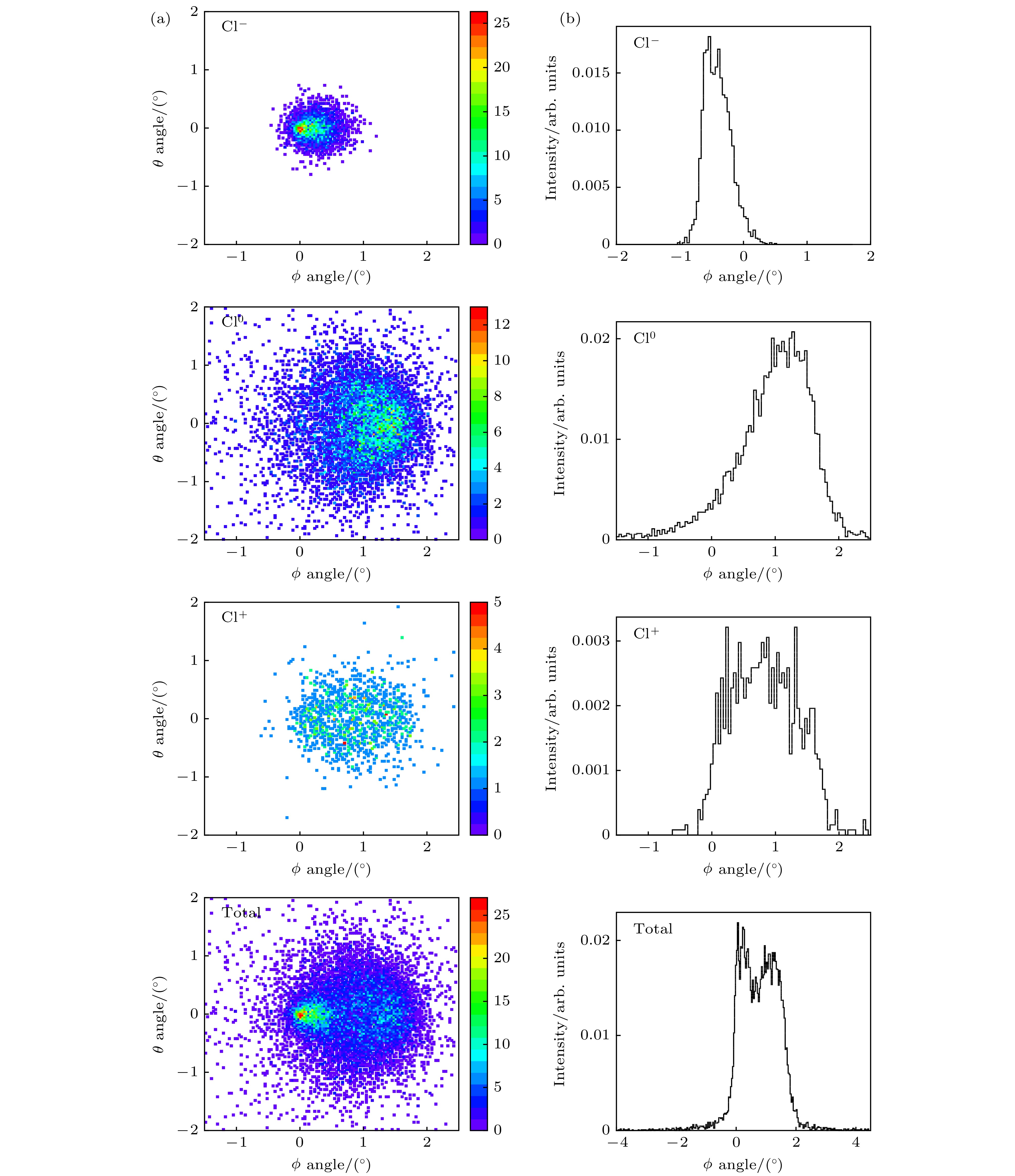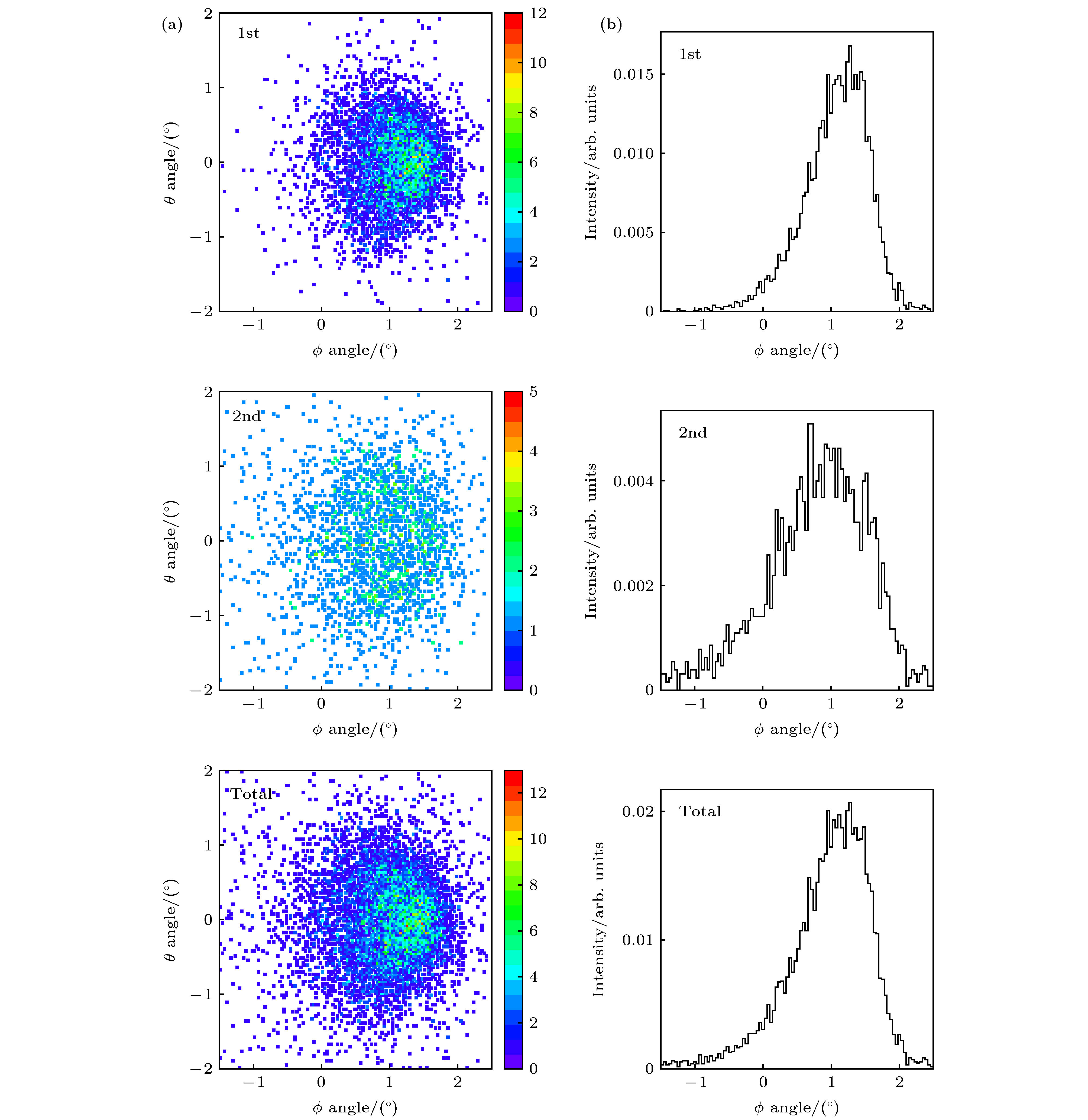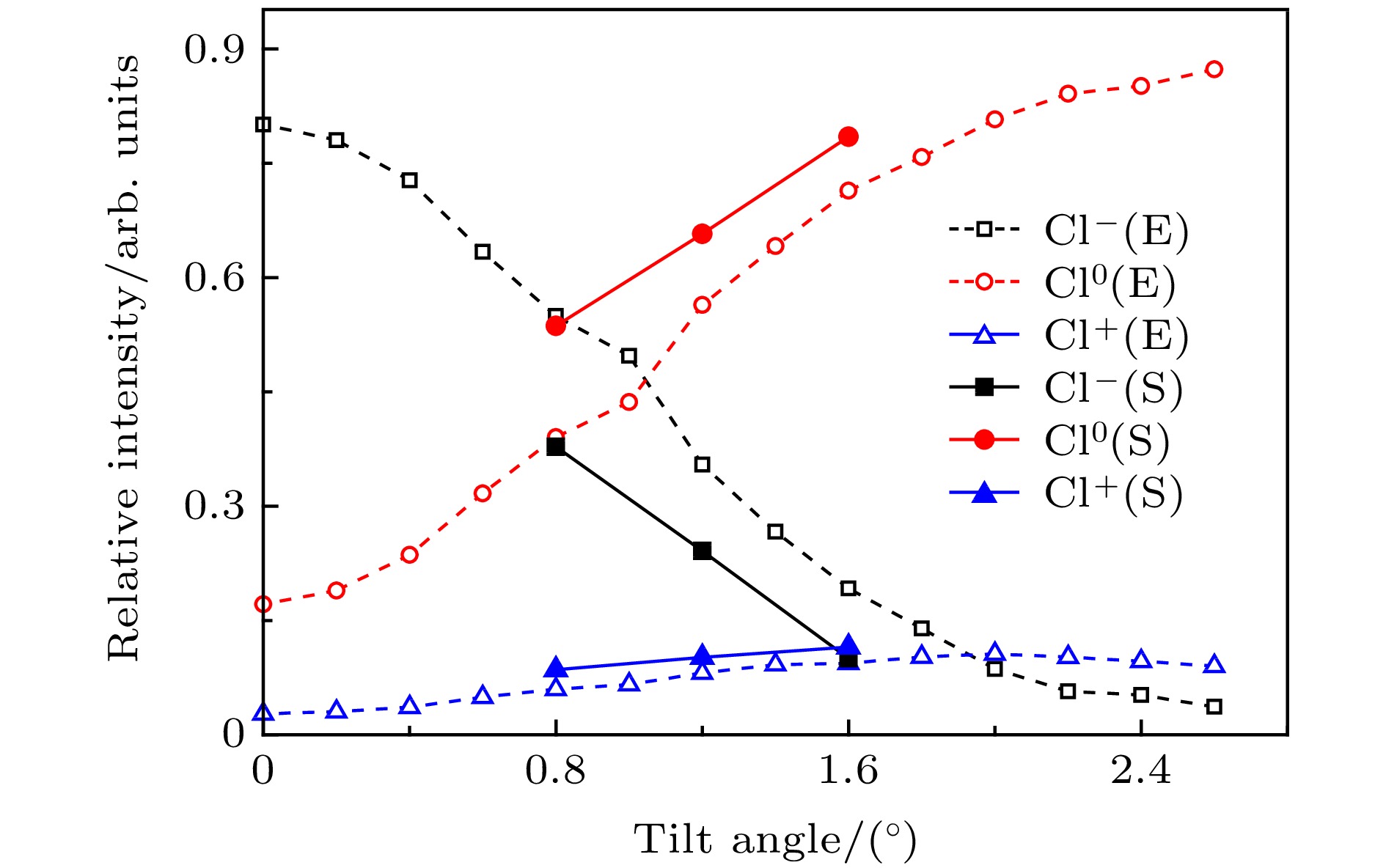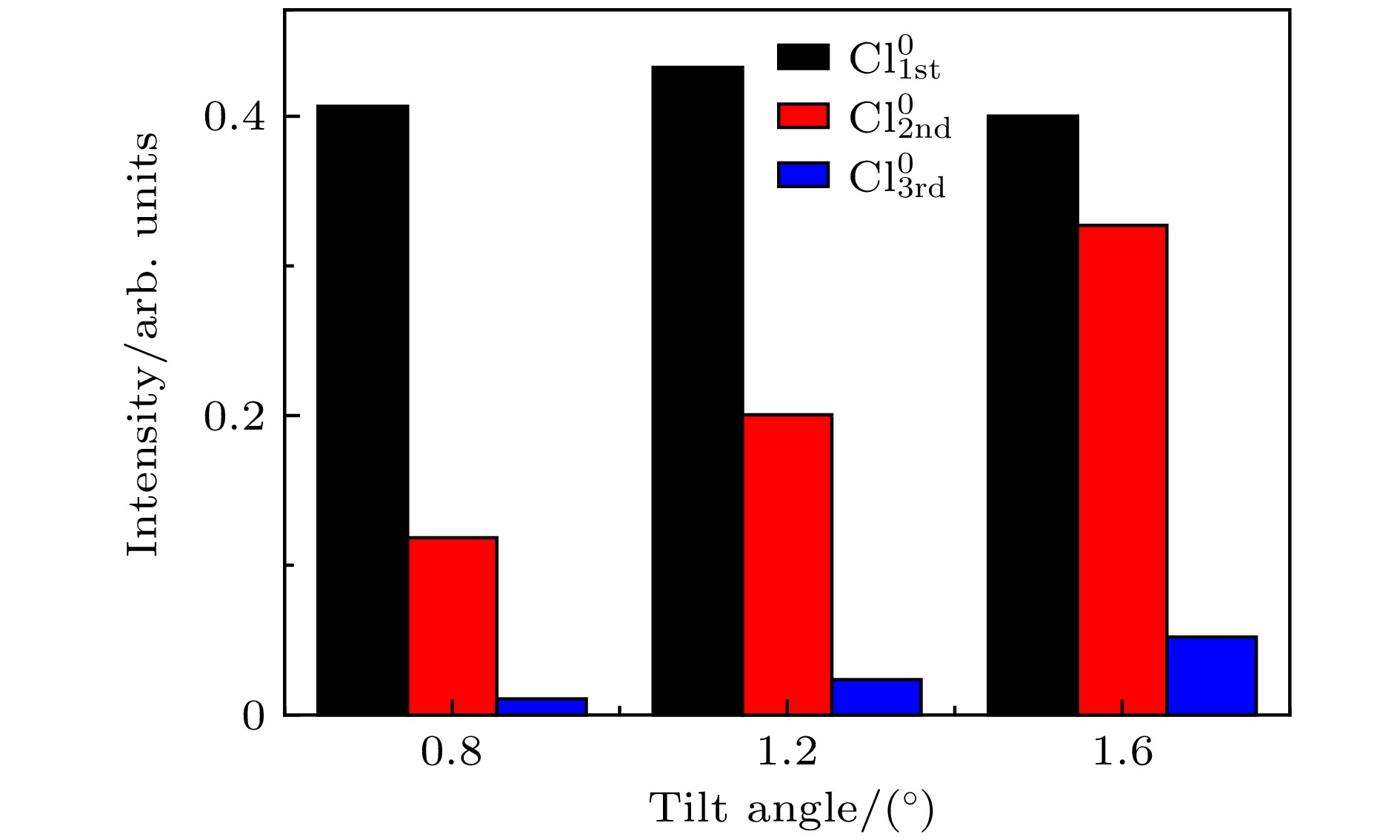-
The transmission of 10-keV Cl– ions through Al2O3 insulating nanocapillaries is studied both by experiment and simulation. The double-peak structure in the transmitted angular distribution is found to be the same as our previous result. The peak around the direction of the primary beam is caused mainly by the directly transmitted Cl–, and the other peak around the tilt angle of Al2O3 nanocapillaries is mainly induced by Cl+ and Cl0. The intensity of transmitted Cl– decreases with the tilt angle increasing, which is in accord with the geometrically allowed transmission. Beyond the geometrically allowed angle, the transmitted projectiles are mainly Cl+ ions and Cl0 atoms. The ratio of transmitted Cl+ ion to Cl0 atom drops as tilt angle increases, and it turns more obvious when the tilt angle is larger than the limit of the geometrical transmission. A detailed physics process was developed within Geometry and Tracking 4 (Geant4) to perform the trajectory simulation, in which the forces from the deposited charges and the image charges, the scattering from the surfaces as well as the charge exchange are taken into consideration. The transmissions at the tilt angle of 1.6o are simulated for the cases without and with deposited charges of –100 e/capillary. For the deposition charge quantity of –100 e/capillary, the majority of the transmitted projectiles are mainly the directly transmitted Cl– ions exiting to the direction of tilt angle, and the transmitted Cl0 and Cl+ account for a very small portion. While for the case with no deposited charges, the simulation results agree well with the experimental results. The dependence of the scattering process on the tilt angle, which results in the different features in the transmitted projectiles, is studied in detail by the simulation. It is found that the transmitted Cl0 atoms exit through single to multiple scattering, and most of transmitted Cl0 atoms exit through single and double scattering, and are centered along the axis of nanocapillaries, while Cl+ ions mainly exit by single scattering, which results in the fact that the intensity of the transmitted Cl0 atoms drops slower than that of the transmitted Cl+ ions with the increase of the tilt angle, leading the ratio of the transmitted Cl+ to Cl0 to decrease as the tilt angle increases in experiment. Our results describe the physical mechanism of low-energy ions through insulating nanocapillaries in detail, i.e. how the scattering process dominates the final transmission. It is found that the transmission of the negative ions in the energy range above 10 keV is caused by the scattering and the charge exchange process. -
Keywords:
- Cl– ions /
- Al2O3 insulating nanocapillaries /
- scattering
[1] Stolterfoht N, Bremer J H, Hoffmann V, Hellhammer R, Fink D, Petrov A, Sulik B 2002 Phys. Rev. Lett. 88 133201
 Google Scholar
Google Scholar
[2] Schiessl K, Palfinger W, Tőkési K, Nowotny H, Lemell C, Burgdőrfer J 2005 Phys. Rev. A 72 062902
 Google Scholar
Google Scholar
[3] Stolterfoht N, Hellhammer R, Bundesmann J, Fink D, Kanai Y, Hoshino M, Kambara T, Ikeda T, Yamazaki Y P 2007 Phys. Rev. A 76 022712
 Google Scholar
Google Scholar
[4] Skog P, Zhang H Q, Schuch R 2008 Phys. Rev. Lett. 101 223202
 Google Scholar
Google Scholar
[5] Zhang H Q, Skog P, Schuch R 2010 Phys. Rev. A 82 052901
 Google Scholar
Google Scholar
[6] Chen Y F, Chen X M, Lou F J, Xu J Z, Shao J X, Sun G Z, Wang J, Xi F Y, Yin Y Z, Wang X A, Xu J K, Cui Y, Ding B W 2009 Chin. Phys. B 18 2739
 Google Scholar
Google Scholar
[7] Zhang H Q, Akram N, Skog P, Soroka I L, Trautmann C, Schuch R 2012 Phys. Rev. Lett. 108 193202
 Google Scholar
Google Scholar
[8] Zhang H Q, Akram N, Soroka I L, Trautmann C, Schuch R 2012 Phys. Rev. A 86 022901
 Google Scholar
Google Scholar
[9] Zhang H Q, Akram N, Schuch R 2016 Phys. Rev. A 94 032704
 Google Scholar
Google Scholar
[10] Ikeda T, Kanai Y, Kojima T M, Iwai Y, Kambara T, Yamazaki Y P, Hoshino M, Nebiki T, Narusawa T 2006 Appl. Phys. Lett. 89 163502
[11] Iwai Y, Ikeda T, Kojima T M, Yamazaki Y, Maeshima K, Imamoto N, Kobayashi T, Nebiki T, Narusawa T, Pokhil G P 2008 Appl. Phys. Lett. 92 023509
 Google Scholar
Google Scholar
[12] Lemell C, Burgdörfer J, Aumayr F 2013 Prog. Surf. Sci. 88 237
 Google Scholar
Google Scholar
[13] Stolterfoht N, Yasunori Y 2016 Phys. Rep. 629 1
 Google Scholar
Google Scholar
[14] Milosavljević A R, Víkor G, Pešić Z D, Kolarž P, Šević D, Marinković B P, Mátéfi-Tempfli S, Mátéfi-Tempfli M, Piraux L 2007 Phys. Rev. A 75 030901
 Google Scholar
Google Scholar
[15] Das S, Dassanayake B S, Winkworth M, Baran J L, Stolterfoht N, Tanis J A 2007 Phys. Rev. A 76 042716
 Google Scholar
Google Scholar
[16] Schiessl K, Tőkési K, Solleder B, Lemell C, Burgdörfer J 2009 Phys. Rev. Lett. 102 163201
 Google Scholar
Google Scholar
[17] 万城亮, 李鹏飞, 钱立冰, 靳博, 宋光银, 高志民, 周利华, 张琦, 宋张勇, 杨治虎, 邵剑雄, 崔莹, Reinhold Schuch, 张红强, 陈熙萌 2016 物理学报 65 204103
 Google Scholar
Google Scholar
Wan C L, Li P F, Qian L B, Jin Bo, Song G Y, Gao Z M, Zhou L H, Zhang Q, Song Z Y, Yang Z H, Shao J X, Cui Y, Schuch R, Zhang H Q, Chen X M 2016 Acta Phys. Sin. 65 204103
 Google Scholar
Google Scholar
[18] 钱立冰, 李鹏飞, 靳博, 靳定坤, 宋光银, 张琦, 魏龙, 牛犇, 万成亮, 周春林, Arnold Milenko Müller, Max Dobeli, 宋张勇, 杨治虎, Reinhold Schuch, 张红强, 陈熙萌 2017 物理学报 66 124101
 Google Scholar
Google Scholar
Qian L B, Li P F, Jin B, Jin D K, Song G Y, Zhang Q, Wei L, Niu B, Wan C L, Zhou C L, Müller A M, Dobeli M, Song Z Y, Yang Z H, Schuch R, Zhang H Q, Chen X M 2017 Acta Phys. Sin. 66 124101
 Google Scholar
Google Scholar
[19] Sun G, Chen X M, Wang J, Chen Y, Xu J, Zhou C, Shao J, Cui Y, Ding B, Yin Y, Wang X, Lou F, Lv X, Qiu X, Jia J, Chen L, Xi F, Chen Z, Li L, Liu Z 2009 Phys. Rev. A 79 052902
 Google Scholar
Google Scholar
[20] Zhang Q, Liu Z l, Li P F, Jin B, Song G Y, Jin D K, Niu B, Wei L, Ha S, Xie Y M, Ma Y, Wan C L, Cui Y, Zhou P, Zhang H Q, Chen X M 2018 Phys. Rev. A 97 042704
 Google Scholar
Google Scholar
[21] Mátéfi-Tempfli S, Mátéfi-Tempfli M, Piraux L, Juhász Z, Biri S, Fekete É, Ivn I, Gáll F, Sulik B, Víkor G, Pálinkás J, Stolterfoht N 2006 Nanotechnology 17 3915
 Google Scholar
Google Scholar
[22] Skog P, Soroka I L, Johansson A, Schuch R 2007 Nucl. Instrum Methods Phys. Res., Sect. B 258 145
 Google Scholar
Google Scholar
[23] Yu M S, Cui H M, Ai F P, Jiang L F, Kong J S, Zhu X F 2018 Electrochem. Commun. 86 80
 Google Scholar
Google Scholar
[24] Yu M S, Chen L, Yang Y B, Xu S K, Zhang K, Cui H M, Zhu X F 2018 Electrochem. Commun. 90 34
 Google Scholar
Google Scholar
[25] Zhang J J, Huang W Q, Zhang K, Li D Z, Xu H Q, Zhu X F 2019 Electrochem. Commun. 100 48
 Google Scholar
Google Scholar
[26] Agostinelli S, Allison J, Amako K, Apostolakis J, Araujo H, Arce P, Asai M, Axen D, Banerjee S, Barrand G, Behner F, Bellagamba L, Boudreau J, Broglia L 2003 Nucl. Instrum. Methods Phys. Res., Sect. A. 506 250
 Google Scholar
Google Scholar
[27] Winecki S, Cocke C L, Fry D, Stöckli M P 1996 Phys. Rev. A 53 4228
 Google Scholar
Google Scholar
[28] Firsov O B 1967 Sov. Phys.-Dokl. 11 732
[29] Batra I P 1982 J. Phys. C: Solid State Phys. 15 5399
 Google Scholar
Google Scholar
[30] Fomin V M, Misko V R, Devreese J T, Brongersma H H 1998 Nucl. Instrum. Methods Phys. Res., Sect. B. 145 545
 Google Scholar
Google Scholar
[31] Lienemann J, Blauth D, Wethekam S, Busch M, Winter H, Wurz P, Fuselier S A, Hertzberg E 2011 Nucl. Instrum. Methods Phys. Res., Sect. B 269 915
 Google Scholar
Google Scholar
[32] Jackson J D 1975 Classical Electrodynamics (2nd Ed.) (New York: Wiley)
[33] Tokesi K, Wirtz L, Burgdorfer J 1999 Phys. Scr. T80 247
 Google Scholar
Google Scholar
-
图 3 (a)不同倾角ψ下10 keV的Cl–穿透角分布的计算结果(黑色为无沉积电荷的结果, 红色为沉积电荷为–100 e/capillary的结果); (b)不同倾角ψ下10 keV的Cl–穿透角分布的实验结果
Figure 3. (a) Calculated transmitted angular distributions for 10 keV-Cl– ions at various tile angles ψ (black lines for no deposited charge and red line for deposited charge of –100 e/capillary); (b) the experimental transmitted angular distributions for 10 keV-Cl– ions at various tile angles ψ.
图 4 加静电场后, (a)不同倾角ψ下10 keV的Cl–穿透粒子的电荷态分布的计算结果(黑色为无沉积电荷的结果, 红色为沉积电荷为–100 e/capillary的结果); (b)不同倾角ψ下10 keV的Cl–穿透粒子的电荷态分布的实验结果
Figure 4. Exerting electrostatic field, (a) thecalculated charge state distributions of transmitted projectiles for 10 keV-Cl– at various tilt angles ψ (black line for no deposited charge and red line for deposited charge of –100 e/capillary); (b) the experimental charge state distributions of transmitted projectiles for 10 keV-Cl– at various tilt angles ψ.
图 5 实验与计算结果的中性穿透粒子(Cl0)角分布的峰位置随倾角的变化(实线是线性函数Y = X)
Figure 5. Peak position of experimental and simulated angular distribution of transmitted neutrals (Cl0) as a function of the tilt angle. The solid line is the linear function that shows the peak position of transmitted neutral shifts according to the tilt angle.
图 7 在不同倾角ψ下10 keV的Cl– 穿透的Cl+/Cl0的比值(红色实心圆是实验结果, 黑色实心矩形是计算结果, 蓝色虚线代表几何穿透角)
Figure 7. Intensity ratio of transmitted Cl+ to Cl0 vs. the tilt angle ψ for the incident ions of 10 keV-Cl–. The red solid circle corresponds to the experimental results; black solid square corresponds to the simulation results; blue dash line indicates the angle within which the geometrical transmission occurs.
图 9 Cl–离子穿过纳米微孔的原理简图(绿线为离子直接穿透的轨迹简图, 红线为一次碰撞散射的轨迹简图, 黑线为二次碰撞散射的简图)
Figure 9. Schematic diagram of Cl– ions transmitted through a nanocapillary. The green line is a schematic diagram of the direct transmission of ions, the red line is a schematic diagram of ions transmitted by single scattering, and the black line is a schematic diagram of ions transmitted by double scattering.
图 12 模拟计算出的倾角为1.2°时经不同散射次数出射的Cl0二维角分布(a)及对应的投影角分布(b)
Figure 12. (a) Two-dimensional transmitted angular distributions and (b) corresponding projections of transmitted Cl0 exited from the capillaries by single scattering and double scattering and the total of them at tilt angle of 1.2° from simulations.
图 14 模拟计算的不同角度0.8°, 1.2°, 1.6°下经过不同碰撞次数的出射的Cl0比例(黑色条形是经一次碰撞出射的, 红色条形是经两次散射出射的, 蓝色条形是经三次碰撞出射的)
Figure 14. Portions of transmitted Cl0 for various scattering at the tilt angle of 0.8°, 1.2°, 1.6°. The black bars stand for single scattering, the red bars for double scattering, and the blue bars for those scattered three times from simulations.
-
[1] Stolterfoht N, Bremer J H, Hoffmann V, Hellhammer R, Fink D, Petrov A, Sulik B 2002 Phys. Rev. Lett. 88 133201
 Google Scholar
Google Scholar
[2] Schiessl K, Palfinger W, Tőkési K, Nowotny H, Lemell C, Burgdőrfer J 2005 Phys. Rev. A 72 062902
 Google Scholar
Google Scholar
[3] Stolterfoht N, Hellhammer R, Bundesmann J, Fink D, Kanai Y, Hoshino M, Kambara T, Ikeda T, Yamazaki Y P 2007 Phys. Rev. A 76 022712
 Google Scholar
Google Scholar
[4] Skog P, Zhang H Q, Schuch R 2008 Phys. Rev. Lett. 101 223202
 Google Scholar
Google Scholar
[5] Zhang H Q, Skog P, Schuch R 2010 Phys. Rev. A 82 052901
 Google Scholar
Google Scholar
[6] Chen Y F, Chen X M, Lou F J, Xu J Z, Shao J X, Sun G Z, Wang J, Xi F Y, Yin Y Z, Wang X A, Xu J K, Cui Y, Ding B W 2009 Chin. Phys. B 18 2739
 Google Scholar
Google Scholar
[7] Zhang H Q, Akram N, Skog P, Soroka I L, Trautmann C, Schuch R 2012 Phys. Rev. Lett. 108 193202
 Google Scholar
Google Scholar
[8] Zhang H Q, Akram N, Soroka I L, Trautmann C, Schuch R 2012 Phys. Rev. A 86 022901
 Google Scholar
Google Scholar
[9] Zhang H Q, Akram N, Schuch R 2016 Phys. Rev. A 94 032704
 Google Scholar
Google Scholar
[10] Ikeda T, Kanai Y, Kojima T M, Iwai Y, Kambara T, Yamazaki Y P, Hoshino M, Nebiki T, Narusawa T 2006 Appl. Phys. Lett. 89 163502
[11] Iwai Y, Ikeda T, Kojima T M, Yamazaki Y, Maeshima K, Imamoto N, Kobayashi T, Nebiki T, Narusawa T, Pokhil G P 2008 Appl. Phys. Lett. 92 023509
 Google Scholar
Google Scholar
[12] Lemell C, Burgdörfer J, Aumayr F 2013 Prog. Surf. Sci. 88 237
 Google Scholar
Google Scholar
[13] Stolterfoht N, Yasunori Y 2016 Phys. Rep. 629 1
 Google Scholar
Google Scholar
[14] Milosavljević A R, Víkor G, Pešić Z D, Kolarž P, Šević D, Marinković B P, Mátéfi-Tempfli S, Mátéfi-Tempfli M, Piraux L 2007 Phys. Rev. A 75 030901
 Google Scholar
Google Scholar
[15] Das S, Dassanayake B S, Winkworth M, Baran J L, Stolterfoht N, Tanis J A 2007 Phys. Rev. A 76 042716
 Google Scholar
Google Scholar
[16] Schiessl K, Tőkési K, Solleder B, Lemell C, Burgdörfer J 2009 Phys. Rev. Lett. 102 163201
 Google Scholar
Google Scholar
[17] 万城亮, 李鹏飞, 钱立冰, 靳博, 宋光银, 高志民, 周利华, 张琦, 宋张勇, 杨治虎, 邵剑雄, 崔莹, Reinhold Schuch, 张红强, 陈熙萌 2016 物理学报 65 204103
 Google Scholar
Google Scholar
Wan C L, Li P F, Qian L B, Jin Bo, Song G Y, Gao Z M, Zhou L H, Zhang Q, Song Z Y, Yang Z H, Shao J X, Cui Y, Schuch R, Zhang H Q, Chen X M 2016 Acta Phys. Sin. 65 204103
 Google Scholar
Google Scholar
[18] 钱立冰, 李鹏飞, 靳博, 靳定坤, 宋光银, 张琦, 魏龙, 牛犇, 万成亮, 周春林, Arnold Milenko Müller, Max Dobeli, 宋张勇, 杨治虎, Reinhold Schuch, 张红强, 陈熙萌 2017 物理学报 66 124101
 Google Scholar
Google Scholar
Qian L B, Li P F, Jin B, Jin D K, Song G Y, Zhang Q, Wei L, Niu B, Wan C L, Zhou C L, Müller A M, Dobeli M, Song Z Y, Yang Z H, Schuch R, Zhang H Q, Chen X M 2017 Acta Phys. Sin. 66 124101
 Google Scholar
Google Scholar
[19] Sun G, Chen X M, Wang J, Chen Y, Xu J, Zhou C, Shao J, Cui Y, Ding B, Yin Y, Wang X, Lou F, Lv X, Qiu X, Jia J, Chen L, Xi F, Chen Z, Li L, Liu Z 2009 Phys. Rev. A 79 052902
 Google Scholar
Google Scholar
[20] Zhang Q, Liu Z l, Li P F, Jin B, Song G Y, Jin D K, Niu B, Wei L, Ha S, Xie Y M, Ma Y, Wan C L, Cui Y, Zhou P, Zhang H Q, Chen X M 2018 Phys. Rev. A 97 042704
 Google Scholar
Google Scholar
[21] Mátéfi-Tempfli S, Mátéfi-Tempfli M, Piraux L, Juhász Z, Biri S, Fekete É, Ivn I, Gáll F, Sulik B, Víkor G, Pálinkás J, Stolterfoht N 2006 Nanotechnology 17 3915
 Google Scholar
Google Scholar
[22] Skog P, Soroka I L, Johansson A, Schuch R 2007 Nucl. Instrum Methods Phys. Res., Sect. B 258 145
 Google Scholar
Google Scholar
[23] Yu M S, Cui H M, Ai F P, Jiang L F, Kong J S, Zhu X F 2018 Electrochem. Commun. 86 80
 Google Scholar
Google Scholar
[24] Yu M S, Chen L, Yang Y B, Xu S K, Zhang K, Cui H M, Zhu X F 2018 Electrochem. Commun. 90 34
 Google Scholar
Google Scholar
[25] Zhang J J, Huang W Q, Zhang K, Li D Z, Xu H Q, Zhu X F 2019 Electrochem. Commun. 100 48
 Google Scholar
Google Scholar
[26] Agostinelli S, Allison J, Amako K, Apostolakis J, Araujo H, Arce P, Asai M, Axen D, Banerjee S, Barrand G, Behner F, Bellagamba L, Boudreau J, Broglia L 2003 Nucl. Instrum. Methods Phys. Res., Sect. A. 506 250
 Google Scholar
Google Scholar
[27] Winecki S, Cocke C L, Fry D, Stöckli M P 1996 Phys. Rev. A 53 4228
 Google Scholar
Google Scholar
[28] Firsov O B 1967 Sov. Phys.-Dokl. 11 732
[29] Batra I P 1982 J. Phys. C: Solid State Phys. 15 5399
 Google Scholar
Google Scholar
[30] Fomin V M, Misko V R, Devreese J T, Brongersma H H 1998 Nucl. Instrum. Methods Phys. Res., Sect. B. 145 545
 Google Scholar
Google Scholar
[31] Lienemann J, Blauth D, Wethekam S, Busch M, Winter H, Wurz P, Fuselier S A, Hertzberg E 2011 Nucl. Instrum. Methods Phys. Res., Sect. B 269 915
 Google Scholar
Google Scholar
[32] Jackson J D 1975 Classical Electrodynamics (2nd Ed.) (New York: Wiley)
[33] Tokesi K, Wirtz L, Burgdorfer J 1999 Phys. Scr. T80 247
 Google Scholar
Google Scholar
Catalog
Metrics
- Abstract views: 13311
- PDF Downloads: 84
- Cited By: 0















 DownLoad:
DownLoad:


